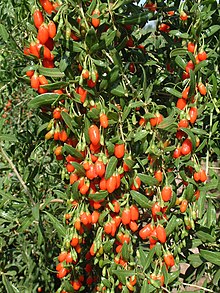
Back جوجى (فواكه) ARZ Goji Catalan Gēu-gī CDO Godži Czech Γκότζι Greek Baya de goji Spanish گوجیبری Persian Gojimarja Finnish Baie de goji French Goxi Galician


Goji, goji berry, or wolfberry (Chinese: 枸杞; pinyin: gǒuqǐ) is the sweet fruit of either Lycium barbarum or Lycium chinense, two closely related species of boxthorn in the nightshade family, Solanaceae.[1] L. barbarum and L. chinense fruits are similar but can be distinguished by differences in taste and sugar content.[2]
Both of these species are native to East Asia,[1] and have been long used in traditional East Asian cuisine. In the United States, varieties of the genus, Lycium, are given the common names, desert-thorn and Berlandier's wolfberry for the species, Lycium berlandieri.[3]
The fruit has also been an ingredient in East Asian traditional medicine, namely traditional Chinese, Japanese, and Korean medicine since at least the 3rd century AD.[2][4] In pharmacopeias, the fruit of the plant is called by the Latin name lycii fructus and the leaves are called herba lycii.[5][6]
Since about 2000, goji berry and derived products have become common in developed countries as health foods or alternative medicine remedies, extending from exaggerated and unproven claims about their health benefits.[7][8][9]
- ^ a b Flint, Harrison Leigh (1997). "Lycium barbarum". Landscape plants for eastern North America: exclusive of Florida and the immediate Gulf Coast. Chichester: John Wiley & Sons. p. 326. ISBN 978-0-471-59919-7.
- ^ a b Lee, HW; Kim, YH; Kim, YH; Lee, GH; Lee, MY (2014). "Discrimination of Lycium chinense and Lycium barbarum by taste pattern and betaine analysis". International Journal of Clinical and Experimental Medicine. 7 (8): 2053–9. ISSN 1940-5901. PMC 4161546. PMID 25232386.
- ^ "Lycium (from Search)". US Department of Agriculture. 2024. Retrieved 7 June 2024.
- ^ Nobuo Kawahara, ed. (2011): "Comparative Studies on Pharmacopoeial Definitions, Requirements and Information for Crude Drugs among FHH Member Countries in 2007". Western Pacific Regional Forum for the Harmonization of Herbal Medicines (FHH). Online document, accessed on 12 June 2018.
- ^ "Lycii fructus Archived 3 January 2019 at the Wayback Machine", European Pharmacopoea 9.3, page 4812
- ^ Ray Upton et al., editors (2010): "Lycium chinense Mill, L. barbarum L., Lycium fruit, Lycii fructus". In American Herbal Pharmacopoeia Botanical Pharmacognosy: Microscopic Characterization Of Botanical Medicines, page 468. Published by CRC Press.
- ^ "Lycium". MedlinePlus. National Library of Medicine, US National Institutes of Health. 4 January 2024. Retrieved 7 June 2024.
- ^ Cite error: The named reference
cbcwas invoked but never defined (see the help page). - ^ Cite error: The named reference
Freelifewas invoked but never defined (see the help page).
© MMXXIII Rich X Search. We shall prevail. All rights reserved. Rich X Search